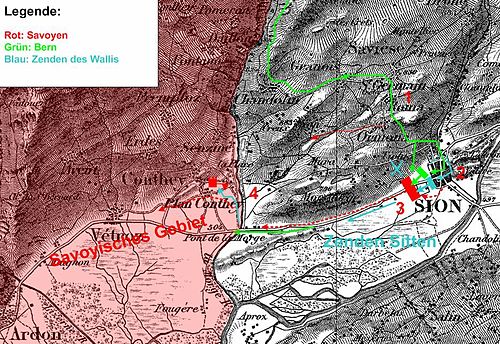Battle of the Planta
| date | November 13, 1475 |
|---|---|
| place | La Planta, near Sion |
| output | Federal victory |
| Parties to the conflict | |
|---|---|
| Commander | |
|
? |
Hans am Hengart, Hans Asperlin |
| Troop strength | |
| around 10,000 men, 1,500 of them mounted nobles | 6,000 to 7,000 men, including 3,000 to 4,000 Valais and 3,000 Swiss from Bern , Freiburg and Solothurn |
| losses | |
|
approx. 1,000 dead, including 300 aristocrats |
Unknown |
The Battle of the Planta was a military conflict between the Duchy of Savoy and the Confederates and Upper Valais during the Burgundian Wars ( 1474 - 1477 ). It took place on November 13, 1475 .
prehistory
In January 1475, Charles the Bold , Duke of Burgundy, signed an alliance with the Duchy of Savoy and the Duchy of Milan. This was done in response to the Eternal Peace that the Confederates concluded with the Emperor ( Habsburg ) in 1474 . Emperor Friedrich III. urged the Confederates to take part in the Imperial War against Charles the Bold , whereupon the Federal Diet authorized Bern to declare war on Burgundy.
The seven Zends of Valais were threatened from two sides by the alliance policy of Burgundy:
- To the west through the Duchy of Savoy , the river Morge borders west of the capital Sion . The relationship with Savoy was characterized by mutual territorial claims and mistrust; there was a real guerrilla war.
- In the east through the Duchy of Milan , which sent mercenaries for Burgundy over the Great St. Bernhard (pass).
In October 1475, the Bernese, who had conquered areas in the Vaud , asked the Valais to attack too. The two attacks of the Valais on the fortified Conthey were unsuccessful. The Bishop of Geneva , Johann Ludwig von Savoyen , was able to hold the positions with his Savoy troops and waited for the main power of the Savoy army.
On November 12th, the main Savoy power under Duchess Yolanda of Savoy arrived in Conthey, around 10,000 men with 1,500 noble men on horseback. The city of Sion had only 300 men available for defense. The Zenden Landsturm , around 3,000 to 4,000 men, was only just approaching.
First phase of the battle
On the morning of November 13th, the main power of the Savoy (1st) crossed the border river Morge and after a short battle (2nd) put the Valaisan vanguard to flight. At the same time, a smaller force of the Savoy (3rd) advanced over the left flank to Savièse, defeated the defenders and plundered and pillaged the villages. The main army now advanced against the city of Sion (Sion) and penetrated the western parts of the city (4th). The now arriving Landsturm of the Zenden could drive the Savoy out of the city again.
Second phase of the battle
The Savoy troops regrouped in front of the city in La Planta. The poorly equipped Valais could not oppose the Savoy in the open field, and some troops of the Landsturm disbanded. Now around 3,000 volunteers (1st) pushed forward from Bern, Freiburg and Solothurn over the Sanetsch Pass towards Savièse and threatened the left flank of the Savoy.
The retreating Valais were asked by the Bernese to take up the fight again, whoever fled was killed (2.).
In order to protect the left flank, the Savoy withdrew a little to the west, the Confederates and the Valais immediately attacked head-on (3.). After a bitter struggle, the Savoyans fled in panic and left the whole entourage behind. The Valais captured six wagons with armor, weapons and armor as well as some banners and 120 warhorses. The losses of the Savoy were great, over 1,000 dead, including 300 nobles and several prisoners. The Allies' losses are unknown, but appear to have been relatively minor. The Valais and Bernese chased the fugitives until nightfall, to Conthey, which was immediately occupied (4th).
consequences
The consequences were devastating for the Duchy of Savoy: In the days after the battle, the Valais conquered the whole of Lower Valais as far as Saint-Maurice and occupied the strategically important Great St. Bernhard Pass without significant resistance. On December 1st, Bern and Freiburg brokered an armistice with the Duchess Yolanda of Savoy.
The bishop of Sitten Walther II. Supersaxo von der Fluhe later refused to return the conquered areas to Savoy and in 1477 incorporated them into the Valais as subject areas. To this end, he relied on the so-called "Carolina", a document that was supposed to prove that the county of Valais was given as a fief by Charles the Great Bishop Theodul . This document was a forgery which the bishop had made to legitimize the conquest of the Lower Valais. Bishop Theodul lived 450 years before Charlemagne.
This military success led the bishops of Valais and the Zenden to an aggressive expansion policy in the following decades.
See also
literature
- Valais history . Volume 1-3. Arthur Fibicher.


